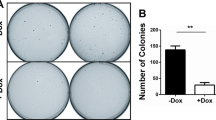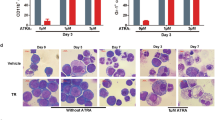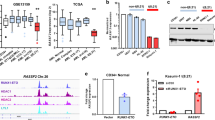Abstract
Acute promyelocytic leukaemia (APL), associated with chromosomal translocations involving the retinoic acid receptor α gene (RARA) and the PML gene, is sensitive to retinoic acid (RA) treatment, while APL patients harbouring translocations between RARA and the PLZF gene do not respond to RA. We have generated PML-RARA and PLZF-RARA transgenic mice and show here that these fusion proteins play a critical role in leukaemogenesis and in determining responses to RA in APL, because PLZF-RARA transgenic mice develop RA-resistant leukaemia, while PML-RARA mice are responsive to RA treatment. We demonstrate that both PML-RARα and PLZF-RARα fusion proteins can act as transcriptional repressors and are able to interact with nuclear receptor transcriptional co-repressors, such as SMRT. PLZF-RARα, but not PML-RARα, can form, via its PLZF moiety, co-repressor complexes which are insensitive to RA. Histone deacetylase inhibitors such as Trichostatin A (TSA), in combination with RA, can overcome the transcriptional repressor activity of PML-RARα and PLZF-RARα as well as the unresponsiveness of PLZF-RARα-expressing leukaemic cells to RA. Thus, our findings unravel a crucial role for transcriptional silencing in APL pathogenesis and resistance to RA in APL.
This is a preview of subscription content, access via your institution
Access options
Subscribe to this journal
Receive 12 print issues and online access
$209.00 per year
only $17.42 per issue
Buy this article
- Purchase on Springer Link
- Instant access to full article PDF
Prices may be subject to local taxes which are calculated during checkout
Similar content being viewed by others
References
Grignani, F. et al. Acute promyelocytic leukaemia: from genetics to treatment. Blood 93, 10–25 (1994).
Warrell, R.P., Jr., de The, H., Wang, Z.Y. & Degos, L. Acute promyelocytic leukaemia. N. Engl. J. Med. 329, 177–189 (1993).
Pandolfi, P.P. PML, PLZF and NPM in the pathogenesis of Acute Promyelocytic Leukaemia. Haematol. 81, 472–482 (1996).
Kalantry, S. et al. Gene rearrangements in the molecular pathogenesis of Acute Promyelocytic Leukaemia. J. Cell. Phys. 173, 288–296 (1997).
Pandolfi, P.P. et al. Structure and origin of the acute promyelocytic leukaemia myl/RARα cDNA and characterization of its retinoid-binding and transactivation properties. Oncogene 6, 1285–1292 (1991).
Kakizuka, A. et al. Chromosomal translocation t(15;17) in human acute promyelocytic leukaemia fuses RARa with a novel putative transcription factor, PML. Cell 66, 663–674 (1991).
de The, H. et al. The PML/RARa fusion mRNA generated by the t(15;17) translocation in acute promyelocytic leukaemia encodes a functionally altered RAR. Cell 66, 675–684 (1991).
Goddard, A.D., Borrow, J., Freemont, I. & Solomon, E. Characterization of a zinc finger gene disrupted by the t(15;17) in acute promyelocytic leukaemia. Science 254, 1371–1374 (1991).
Chen, Z. et al. Fusion between a novel Kruppel-like zinc finger gene and the retinoic acid receptor-alpha locus due to a variant t(11;17) translocation associated with acute promyelocytic luekaemia. EMBO J. 12, 1161–1167 (1993).
Pandolfi, P.P. et al. Genomic variability and alternative splicings generate multiple PML/RARoc transcripts that encode aberrant PML proteins and PML/RARa isoforms in acute promyelocytic leukaemias. EMBO J. 11, 1397–1407 (1992).
Reddy, B.A., Etkin, L.D. & Freemont, P.S. A novel zinc finger coiled-coil domain in a family of nuclear proteins. Trends Biochem. Sci. 17, 344–345 (1992).
Li, J.Y. et al. Sequence-specific DNA binding andtranscriptional regulation by the promyelocytic leukaemia zinc finger protein. J. Biol. Chem. 272, 22447–22455 (1997).
Koken, M.H.M. et al. Leukaemia-associated retinoic acid receptor alpha fusion partners, PML and PLZF, heterodimerize and colocalize to nuclear bodies [In Process Citation]. Proc. Natal. Acad. Sci. USA 94, 10255–10260 (1997).
Chambon, P. A decade of molecular biology of retinoic acid receptors. Faseb J. 10, 940–954 (1996).
Grunstein, M. Histone acetylation in chromatin structure and transcription. Nature 389, 349–352 (1997).
Smith, M.A., Parkinson, D.R., Cheson, B.D. & Friedman, M.A. Retinoids in cancer therapy. J. Clin. Oncol. 10, 839–864 (1992).
Gudas, L., Sporn, M. & Roberts, A. . in The Retinoids: Cellular biology and biochemistry of the retinoids. 443–520 (Raven Press, New-York, 1994).
Fenaux, P., Chomienne, C. & Degos, L., Acute Promyelocyctic Leukaemia:Biology and Treatment. Sem. One. 24, 92–102 (1997).
Licht, J.D. et al. Clinical and molecular characterization of a rare syndrome of acute promyelocytic leukaemia associated with translocation (11;17). Blood 85, 1083–1094(1995).
Perez, A. et al. PML/RAR homodimers: distinct DNA binding properties and heteromeric interactions with RXR. EMBO J. 12, 3171–3182 (1993).
Jansen, J.H. et al. Multimeric complexes of the PML-retinoic acid receptor alpha fusion protein in acute promyelocytic leukaemia cells and interference with retinoid and peroxisome-proliferator signaling pathways.Proc. Natal. Acad. Sci. USA 92, 7401–7405 (1995).
Licht, J.D. et al. Reduced and altered DNA-binding and transcriptional properties of the PLZF-retinoic acid receptor-oc chimera generated in t(11;17)-associated acute promyelocytic leukaemia. Oncogene 12, 323–336 (1996).
Dong, S. et al. Amino-terminal protein-protein interaction motif (POZ-domain) is responsible for activities of the promyelocytic leukaemia zinc finger-retinoic acid receptor-a fusion protein. Proc. Natal. Acad. Sci. USA 93, 3624–3629 (1996).
Kastner, P. et al. Structure, localization and transcriptional properties of two classes of retinoic acid receptor alpha fusion proteins in acute promyelocytic leukaemia (APL): structural similarities with a new family of oncoproteins. EMBO J. 11, 629–642(1992).
Chen, Z. et al. PLZF-RAR alpha fusion proteins generated from the variant t(11;17)(q23;q21) translocation in acute promyelocytic leukaemia inhibit ligand-dependent transactivation of wild-type retinoic acid receptors. Proc Natal. Acad. Sci. USA 91, 1178–1182 (1994).
Dyck, J. et al. A novel macromolecular structure is a target of the promyelocyte-retinoic acid receptor oncoprotein. Cell 76, 333–343 (1994).
Koken, M.H.M. et al. The t(15; 17) translocation alters a nuclear body in a retinoic acid-reversible fashion. EMBO J. 13, 1073–1083 (1994).
Weis, K. et al. Retinoic acid regulates aberrant nuclear localization of PML-RARoc in acute promyelocytic luekemic cells. Cell 76, 345–356 (1994).
Nervi, C. et al. Characterization of the PML/RARa chimeric product of the acute promyelocytic leukaemia specific t(15;17) translocation. Cancer Res. 52, 3687–3692 (1992).
Ruthardt, M. et al. Opposite effects of the acute promyelocytic leukaemia PML-retinoic acid receptor alpha (RAR alpha) and PLZF-RAR alpha fusion proteins on retinoic acid signalling. Mol. Cell. Biol. 17, 4859–4869 (1997).
Yoshida, M., Horinouchi, S. & Beppu, T. Trichostatin A and trapoxin: novel chemical probes for the role of histone acetylation in chromatin structure and function. Bioessays 17, 423–430 (1995).
He, L.-Z. et al. Acute leukaemia with promyelocytic features in PML/RARa transgenic mice. Proc. Natal. Acad. Sci. USA 94, 5302–5307 (1997).
Goldman, J.M. Chronic myeloid leukaemia. Curr. Opin. Hematol. 4, 277–285 (1997).
Warrell, R.P., et al. Differentiation therapy of acute promyelocytic leukaemia with tretinoin (all-trans-retinoic acid). N. Engl. J. Med 324, 1385–1393 (1991).
Castaigne, S. et al. All-trans retinoic acid as a differentiation therapy for acute promyelocytic leukaemia. I. Clinical results. Blood 76, 1704–1709 (1990).
Chen, S.-J. et al. Rearrangements of the retinoic acid receptor alpha and promyelocytic leukaemia zinc finger genes resulting from t(11;17)(q23;21) in a patient with acute promyelocytic leukaemia. J. Clin. Invest. 91, 2260–2267 (1993).
Jansen, J.H., de Ridder, M. C., Erpelinck, C., Geertsma, W. & de Greef, G.E. Granulocytic Differentiation of t(11;17) Positive AML-M3 Cells. Blood 88, 3421–3173 (1996).
Grisolano, J.L., Wesselschmidt, R.L., Pelicci, P.G. & Ley, T.J. Altered myeloid development and acute leukaemia in transgenic mice expressing PML-RARa under control of cathepsin G regulatory sequences. Blood 89, 376–387 (1997).
Brown, D. et al. A PMLRARa transgene initiates murine acute promyelocytic leukaemia. Proc. Natal. Acad. Sci. USA 94, 2551–2556 (1997).
Lafage-Pochitaloff, M. et al. Acute promyelocytic luekemia cases with nonreciprocal PML/RARa or RARa/PML fusion genes. Blood 85, 1169–1174 (1995).
Hong, S.H., David, G., Wong, C.W., Dejean, A. & Privalsky, M.L. SMRT corepressor interacts with PLZF and with the PML-retinoic acid receptor alpha (RARalpha) and PLZF-RARalpha oncoproteins associated with acute promyelocytic leukaemia. Proc. Natal. Acad. Sci. USA 94, 9028–9033 (1997).
Heinzel, T. et al. A complex containing N-CoR, mSin3 and histone deacetylase mediates transcriptional repression. Nature 387, 43–48 (1997).
Alland, L. et al. Role for N-CoR and histone deacetylase in Sin3-mediated transcriptional repression. Nature 387, 49–55 (1997).
Hassig, C.A., Fleischer, T.C., Billin, A.N., Schreiber, S.L. & Ayer, D.E. Histone deacetylase activity is required for full transcriptional repression by mSin3A. Cell 89, 341–347(1997).
Laherty, C.D. et al. Histone deacetylases associated with the mSin3 corepressor mediate mad transcriptional repression. Cell 89, 349–356 (1997).
Dermime, S. et al. Occurrence of resistance to retinoic acid in the acute promyelocytic leukaemia cell line NB4 is associated with altered expression of the pml/RAR alpha protein. Blood 82, 1573–1577 (1993).
Shao, W., Benedetti, L., Lamph, W.W., Nervi, C. & Miller Jr., W.H., A Retinoid-Resistant Acute Promyelocytic Leukaemia Subclone Expresses a Dominant Negative PML-RARa Mutation. Blood 89, 4282–4289 (1997).
Ding, W. et al. Retinoic Acid receptor alpha (RARa)-region mutations jn the PML-RARa fusion gene of acute promyelocytic leukaemia (APL) patients after relapse from all-trans retinoic acid (ATRA) therapy, Blood 90, 415a (1997).
Lea, M.A. & Tulsyan, N. Discordant effects of butyrate analogues on erythroleukaemia cell proliferation, differentiation and histone deacetylase. Anticancer. Res. 15, 879–883 (1995).
Darkin-Rattray, S.J. et al. Apicidin: a novel antiprotozoal agent that inhibits parasite histone deacetylase. Proc. Natal. Acad. Sci. USA 93, 13143–13147 (1996).
Collins, A.F. et al. Oral Sodium Phenylbutyrate therapy in homozygous (3-Thalassemia: a clinical trial. Blood 85, 43–49 (1995).
Rousselot, P. et al. The PML-RAR alpha gene product of the t(15; 17) translocation inhibits retinoic acid-induced granulocytic differentiation and mediated transactivation in human myeloid cells. Oncogene 9, 545–551 (1994).
Horlein, A.J. et al. Ligand-independent repression by the thyroid hormone receptor mediated by a nuclear receptor co-repressor. Nature 377, 397–404 (1995).
Gaub, M.P. et al. Immunodetection of multiple species of retinoic acid receptor alpha: evidence for phosphorylation. Exp. Cell Res. 201, 335–346 (1992).
Borden, K.L.B. et al. The solution structure of the RING finger domain from the acute promyelocytic leukaemia proto-oncoprotein PML. EMBO J. 14, 1532–1541 (1995).
Chomczynski, P. & Sacchi, N. Single-step method of RNA isolation by acid guanidium thiocyanate-phenol-chloroform extraction. Anal. Biochem. 162, 156–159 (1987).
Longo, L. et al. Rearrangements and aberrant expression of the RARa gene in acute promyelocytic leukaemias. J. Exp. Med. 172, 1571–1575 (1990).
Sambrook, J., Fritsch, E.F. & Maniatis, T. Molecular cloning: a laboratory manual. (Cold Spring Harbor Laboratory Press, Plainview, NY, 1989).
Dignam, J.D., Lebovitz, R.M. & Roeder, R.G. Accurate transcription initiation by RNA polymerase II in a soluble extract from isolated mammalian nuclei. Nucl. Acids. Res. 11, 1475–1489 (1983).
Author information
Authors and Affiliations
Corresponding author
Rights and permissions
About this article
Cite this article
He, LZ., Guidez, F., Tribioli, C. et al. Distinct interactions of PML-RARα and PLZF-RARα with co-repressors determine differential responses to RA in APL. Nat Genet 18, 126–135 (1998). https://doi.org/10.1038/ng0298-126
Received:
Accepted:
Issue Date:
DOI: https://doi.org/10.1038/ng0298-126
This article is cited by
-
A novel fusion protein TBLR1-RARα acts as an oncogene to induce murine promyelocytic leukemia: identification and treatment strategies
Cell Death & Disease (2021)
-
Acute Promyelocytic Leukemia: A History over 60 Years—From the Most Malignant to the most Curable Form of Acute Leukemia
Oncology and Therapy (2019)
-
Differentiation therapy revisited
Nature Reviews Cancer (2018)
-
Functions and dys-functions of promyelocytic leukemia protein PML
Rendiconti Lincei. Scienze Fisiche e Naturali (2018)
-
Structural Characterization of the SMRT Corepressor Interacting with Histone Deacetylase 7
Scientific Reports (2017)



